AstroTaverna Plugin AstroTools
AstroTaverna provides a collection of built-in data manipulation services, listed as Astro tools within Taverna’s services panel. These services can be dragged and added to the workflow diagram in the central design panel.
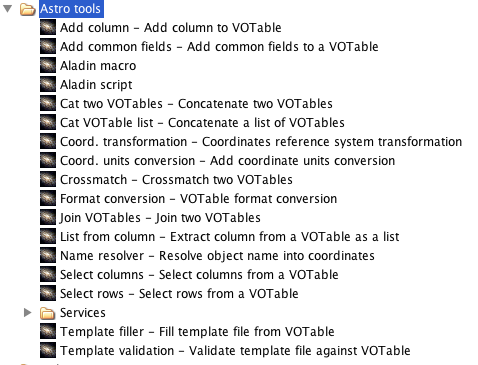
Data manipulation, filtering and cross matching
Given that the data returned by VO services are interoperable VOTables, there is a need for tools allowing actions for efficiently manipulating tabular data, as well as tools providing format conversion between VOTable format and others widely used tabular formats in astronomy research (e.g. FITS, CSV, TST, ASCII, HTML, etc.). Furthermore, spatial table cross matching (finding rows in other tables which might be near a given position, with a prescribed tolerance) and table joins on common keys are also common actions that need to be covered in data manipulation basic capabilities.


The service applies a file format transformation to the table. Using the configure service option you can choose between direct VOTable input, a URL or a File. If the input is a File path then the output is a File path whereas the output is a string with the VOTable content in the remaining cases. Valid input formats are: fits, colfits, votable, ascii, csv, tst, ipac, wdc. Valid output formats are: fits, colfits, votable, ascii, csv, tst.

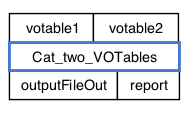
The service returns a VOTable resulting from concatenating two similar VOTableS. The tables must be of similar form (same number and types of columns). Using the configure service option you can choose between direct VOTable input, a URL or a File. If the input is a File path then the output is a File path whereas the output is a string with the VOTable content in the remaining cases.

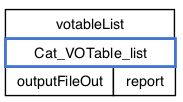
The service returns a VOTable resulting from concatenating a list of similar VOTables. The tables must be of similar form (same number and types of columns). Using the configure service option you can choose between direct list of VOTable input, URLs or Files. If the input are File paths then the output is a list of File paths whereas the output is a list of strings each with a VOTable content in the remaining cases.

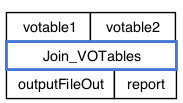
The service makes the join of two VOTables with the same number of rows. Using the configure service option you can choose between direct VOTable input, a URL or a File. If the input is a File path then the output is a File path whereas the output is a string with the VOTable content in the remaining cases.


The service receives two VOTables and returns a VOTable resulting from joining the first row of commonrowVOTable to each row in mainVOTable. Using the configure service option you can choose between direct VOTable input, a URL or a File. If the input is a File path then the output is a File path whereas the output is a string with the VOTable content in the remaining cases.


The service returns a VOTable resulting from crossmatching two VOTables. Using the configure service option you can choose between direct VOTable input, a URL or a File. There are additional configuration options, params and tuning values following STILTS syntax. If the input is a File path then the output is a File path whereas the output is a string with the VOTable content in the remaining cases.


The service returns a VOTable whose columns are the specfied in filter. Using the configure service option you can choose between direct VOTable input, a URL or a File. If the input is a File path then the output is a File path whereas the output is a string with the VOTable content in the remaining cases. The configure option also allows selection by UCDs, column names should be separated by a space, complex UCD cannot include spaces and must use ';' as a separator. If column names is selected as filter type you can include the column names or the index of the column (the first column is '1': $1).
Filter examples:
ColumnId RA DEC flux_20 $7 $10
phot.flux.density;em.radio.750-1500MHz stat.error;phot.flux.density

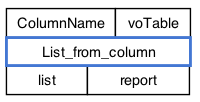
Given a VOTable and a ColumnName, the service returns a list of values corresponding to the specified column. Using the configure service option you can choose between direct VOTable input, a URL or a File.

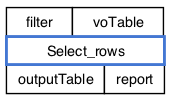
The service returns a VOTable whose rows match the filter expression (see STILTS and Topcat documentation). A column in the filter may be referenced by its name or its column index ($1, $2, $3, ...) Using the configure service option you can choose between direct VOTable input, a URL or a File. If the input is a File path then the output is a File path whereas the output is a string with the VOTable content in the remaining cases.
Filter examples:
(RA > 230 && DEC < 20) || RA <=200
startsWith( TYPE, "S" ) || equals( TYPE, "GALAXY" )
Data transformation
AstroTaverna also provides a collection of services for transformation of VOTable data. These include the addition of columns based on calculations and/ or basic combination of existing ones, following algebraic expressions, transformation of sky coordinates and between different reference systems (e.g. equatorial, ecliptic, galactic, and others), resolution of astronomical object names into equatorial (Right Ascension, Declination) coordinates using the Sesame service , as well as the conversion of coordinates between different units

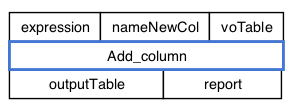
The service returns a VOTable with a new column nameNewCol resulting of evaluating the expression (see STILTS and Topcat documentation). Using the configure option you can choose between direct VOTable input, a URL or a File. If the input is a File path then the output is a File path whereas the output is a string with the VOTable content in the remaining cases.


The service returns a VOTable with a new column namenewCol resulting of aplying a spatial units transformation function selected in the configure service option to the values in column nameColumn. A column may be referenced by its name or its column index ($1, $2, $3, ...). Using the configure option you can choose between direct VOTable input, a URL or a File. If the input is a File path then the output is a File path whereas the output is a string with the VOTable content in the remaining cases.


The service adds two columns nameRA and nameDEC to a VOTable by resolving the position from the values in column objectName. The object name may be referenced by the column name or the column index ($1, $2, $3, ...) Using the configure service option you can choose between direct VOTable input, a URL or a File. If the input is a File path then the output is a File path whereas the output is a string with the VOTable content in the remaining cases.


The service adds two columns nameLongOut and NameDecOut to a VOTable representing position on the sky. The values are determined by converting a sky position whose coordinates are contained in existing columns nameRAIn and nameDecIn. The configure option allows selection of the input and output coordinate systems involved in the transformation, the units input provides the existing units of the coordinates (degrees, radians or sexagesimal). A column may be referenced by its name or its column index ($1, $2, $3, ...) Using the configure service option you can choose between direct VOTable input, a URL or a File. If the input is a file path then the output is a File path whereas the output is a string with the VOTable content in the remaining cases.
Template building
Other two services have been added related with the creation and validation of text files using templates. These templates may be provided in the workflow, and used together with information extracted from VOTables in order to create local files on-the-fly (e.g. software configuration files or input data files in a given specific format).


The service receives a VOTable and a template whose keywords are replaced by the values in the VOTable. The keywords matches the format $keyword$, where keyword corresponds necessarily to a column name in the VOTable. A file will be created for each row in the VOTable and its names correspond to the value given in the column ColumnNameWithResultFileName. Using the configure service option you can choose between direct input, a URL or a File.

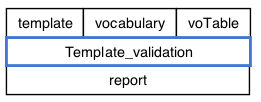
The service receives a VOTable, a template whose keywords matches the format $keyword$ and a vocabulary (words in different lines). The service checks that each keyword in the template correponds to a word in the vocabulary but also to a column name in the VOTable. Using the configure service option you can choose between direct input, a URL or a File.
Scripting
More complex data transformations may be possible using the Tool service provided by Taverna Workbench to locally execute specific command line software or OS commands and small script files. This is especially useful when adding existing snippets of scripts, commonly used in astronomy research (i.e. Python, bash, etc.)

Aladin Integration
AstroTaverna also integrates with Aladin VO software, allowing the user to execute macros and scripts using data extracted from VOTables provided by VO services. These services may be configured with the GUI option enabled, which triggers the visual automated execution of actions on Aladin during the process of workflow execution. The specific output of these Aladin services is a VOTable containing the path and filenames of the final images and planes saved on the local disk during the executions of macros and/ or scripts, according to the commands present on the scripts.


It executes an Aladin macro by receiving a macro script and a parameters file. You may choose between direct input or file input and also you may see the Aladin window if you choose GUI option.


It executes an Aladin script. You may choose between direct input or file input and also you may see the Aladin window if you choose GUI option.
Web Services Interoperability
The orchestration of external web services in workflows would greatly benefit from the adoption of web services interoperability standards. In this context, the PDL - Parameter Description Language has been developed as an IVOA Recomendation in order to deal with web services interoperability in the VO. Next versions of the AstroTaverna plugin will provide a client for PDL self-described services, allowing data input validation before service invocation, providing service metadata description, and services interoperability in the design process of workflows.
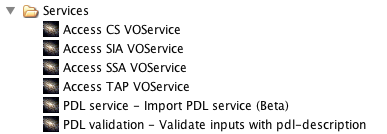
| 






































